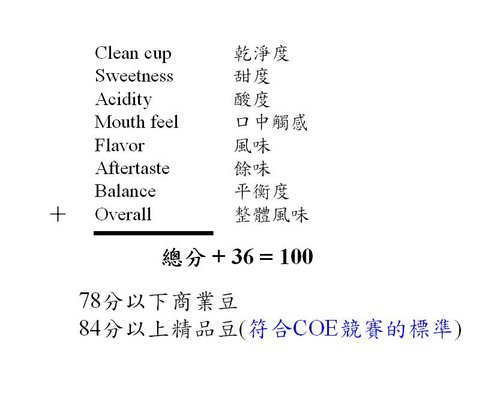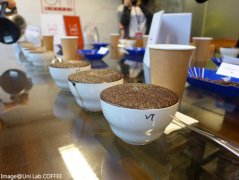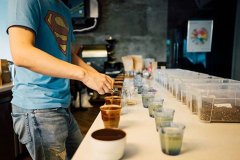The difference between scaa Coffee Cup Test and CoE Cup Test what is the difference in coffee cup testing methods?

Professional coffee knowledge exchange more coffee bean information please follow the coffee workshop (Wechat official account cafe_style)
Why is the coffee grindability standard measured by the cup so important? What is the grinding degree of the standard cup?
Published by the American Coffee Association (National Coffee Association)
Report on the Development trend of Coffee Beverage in 2005
Find that consumers who buy coffee
Forty-eight percent of coffee gluttons feel that the uniqueness of taste / flavor (taste; unique/ different flavor) is the factor they care about most when buying.
33% of the main reasons for determining whether coffee is good or bad.
The second is the brand, price, baking style and so on.
Highlight the necessity of coffee cup testing.
Cup test (Cupping)
Because planting, picking, processing and roasting all affect the flavor of coffee.
The cup test shows the original flavor of coffee beans without any cooking skills.
It is an important skill to find out the characteristics of coffee.
The main purpose of cup test
1. Explore the original characteristics of coffee, including advantages and disadvantages
2. Explore the roasting characteristics of coffee and find out the advantages that are acceptable to the market, including the bean blending model.
3. According to the cup test results, decide whether or not to purchase and make decisions.
Some suggestions on coffee planting and raw bean treatment, preservation and logistics were put forward.
Cup testing environment & facilities
Suitable environment
There's no smell.
Perfume, pungent smell, food aroma. (.)
The cup testing room should be clean, bright, comfortable,
Be quiet (turn off your phone and don't discuss it when tasting)
Cup testing facilities:
Bean baking equipment (bean dryer, Agtron color card, bean grinder)
Cup measuring room
Cup test articles
Cup test articles
Water, heating equipment
Cup test coffee beans, raw beans, control beans
Electronic scale, bean plate, bean grinder
Cup spoon
Glass or ceramic cup (to be mixed with powder), cup lid
Tables, chairs, whiteboards
Cup meter, handwriting board, pencil, small fluorescent lamp, color plate
Matters needing attention in cup test
The night before,
Don't eat stimulating food, get enough sleep and relax.
On the same day
Fasting irritants (garlic, onions, chili, etc.) Chewing gum
Ban perfume, cologne and flavored cosmetics
Prohibition of mouthwash and dental floss containing cleaning ingredients
Instant attention and stable mood
Cup pre-test correction
Objective:
Because everyone's feeling intensity of taste and smell is different, especially the cognition of smell is also different, so basic correction should be made before cup test, which can be used as the benchmark of cup test.
Taste correction: sour, sweet, salty (bitter)
Olfactory correction:
36 common coffee aromas (Le Nez du Caf é)-France
(for beginners, there are 7 kinds of 5Mui per day)
Cup Calibration-Taste (COE Specification)
Salinity test (strong, medium, weak)
NaCl 0.05%, 0.1%, 0.2%
Acidity test (strong, medium, weak)
Citric acid 0.005, 0.01%, 0.02%
Sweetness test (strong, medium, weak)
Sucrose 0.5%, 1%, 2%
Cup test comparison
At present, the cup testing process is commonly used in the world.
Such as the American Fine Coffee Association (The Specialty Coffee Association of America, SCAA),
Coffee Competition Organization (Cup of Excellence, COE)
SCAA
CoE
one
Fragrance / Aroma
Aroma (fragrance is not scored)
two
Flavor
Clean cup cleanliness
three
Aftertaste
Sweetness sweetness
four
Acidity
Acidity acidity
five
Body
Mouth feel has a touch in his mouth.
six
Uniformity consistency
Flavor flavor
seven
Balance
Aftertaste aftertaste
eight
Clean cup
Balance balance degree
nine
Sweetness
Overall overall flavor
ten
Overall
Total score
one hundred
64 + 36 (basic score)
This article adopts COE process and grading method.
COE cup testing process
COE scoring method
Cup test coffee beans
The baking procedure stipulates that:
Bake the beans within 24 hours before the cup test, and place them for 8 hours after packing.
Baking degree:
Mainly light baking, Agtron/SCAA tile # 65 color color 55 (color card)
Baking time:
8Murray for 12 minutes, no scorched objects
Coffee cup brewing standard
Dry cleaning bean grinder before grinding
Water quality TDS regulations: 125--175ppm
(total dissolved solids Total Dissolve Solids)
Ratio of water to powder:
1: 19-1: 20 (Whip W)
Cup testing technique
Smell dried incense (within 10 min after grinding)
Inject hot water (93 ℃, within 10 min after grinding)
Smell damp incense (within 15 min after grinding)
Slag breaking technique (surface disturbance)
Sipping (high, medium and low temperature)
A small sip of 5 murals 10 cc
The length of stay is 5 Murray for 10 seconds.
The interval time is 15 Murray 10 seconds.
Have a good evaluation environment
In order to have a high quality cup test.
.
Important Notice :
前街咖啡 FrontStreet Coffee has moved to new addredd:
FrontStreet Coffee Address: 315,Donghua East Road,GuangZhou
Tel:020 38364473
- Prev

Coffee what is the cup test identification coffee cupping? The initial experience of scaa Coffee Cup Test process
Professional coffee knowledge exchange more coffee bean information please follow the coffee workshop (Wechat official account cafe_style) cup coffee grindability standard why is it so important? What is the grinding degree of the standard cup? Many people start their mornings with a cup of coffee, which is refreshing and savoring the aroma and taste of the coffee running down the throat. In recent years
- Next

Professional coffee cup tester tutorial cup test main purpose, coffee cup test process and standard parameters
Professional coffee knowledge exchange More coffee bean information Please pay attention to coffee workshop (Weixin Official Accounts cafe_style) Why is the coffee grinding standard measured by cup so important? How much is the standard cup grind? Coffee cup test is an international standard method for evaluating coffee flavor, which objectively and collectively judges the sweetness and sourness, bitterness, aftertaste and aroma of coffee.
Related
- Detailed explanation of Jadeite planting Land in Panamanian Jadeite Manor introduction to the grading system of Jadeite competitive bidding, Red bid, Green bid and Rose Summer
- Story of Coffee planting in Brenka region of Costa Rica Stonehenge Manor anaerobic heavy honey treatment of flavor mouth
- What's on the barrel of Blue Mountain Coffee beans?
- Can American coffee also pull flowers? How to use hot American style to pull out a good-looking pattern?
- Can you make a cold extract with coffee beans? What is the right proportion for cold-extracted coffee formula?
- Indonesian PWN Gold Mandrine Coffee Origin Features Flavor How to Chong? Mandolin coffee is American.
- A brief introduction to the flavor characteristics of Brazilian yellow bourbon coffee beans
- What is the effect of different water quality on the flavor of cold-extracted coffee? What kind of water is best for brewing coffee?
- Why do you think of Rose Summer whenever you mention Panamanian coffee?
- Introduction to the characteristics of authentic blue mountain coffee bean producing areas? What is the CIB Coffee Authority in Jamaica?

